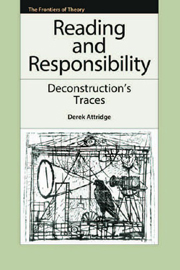Book contents
- Frontmatter
- Contents
- Acknowledgements
- Series Editor's Preface
- Introduction
- 1 Derrida, Deconstruction and Literary Criticism
- 2 Deconstruction Today: Literature, Postcolonialism and the Secret
- 3 Following Derrida
- 4 The Impossibility of Ethics: On Mount Moriah
- 5 Arche-jargon
- 6 Deconstruction and Fiction
- 7 Posthumous Infidelity: Derrida, Levinas and the Third
- 8 Roland Barthes's Obtuse, Sharp Meaning and the Responsibilities of Commentary
- 9 Nothing to Declare: J. Hillis Miller and Zero's Paradox
- 10 Radical Atheism and Unconditional Responsibility
- 11 The Place of Deconstruction: A Conversation with Jean-Michel Rabaté
- Bibliography
- Index
8 - Roland Barthes's Obtuse, Sharp Meaning and the Responsibilities of Commentary
Published online by Cambridge University Press: 12 September 2012
- Frontmatter
- Contents
- Acknowledgements
- Series Editor's Preface
- Introduction
- 1 Derrida, Deconstruction and Literary Criticism
- 2 Deconstruction Today: Literature, Postcolonialism and the Secret
- 3 Following Derrida
- 4 The Impossibility of Ethics: On Mount Moriah
- 5 Arche-jargon
- 6 Deconstruction and Fiction
- 7 Posthumous Infidelity: Derrida, Levinas and the Third
- 8 Roland Barthes's Obtuse, Sharp Meaning and the Responsibilities of Commentary
- 9 Nothing to Declare: J. Hillis Miller and Zero's Paradox
- 10 Radical Atheism and Unconditional Responsibility
- 11 The Place of Deconstruction: A Conversation with Jean-Michel Rabaté
- Bibliography
- Index
Summary
Searching for a name to give to the excessive, exorbitant connotation – what he calls ‘the third meaning’ – that he senses in certain Eisenstein stills, Roland Barthes comes upon the Latin word obtusus, or perhaps more accurately, it comes to him. He explains why it seems just right:
Obtusus means blunted, rounded … An obtuse angle is greater than a right angle: an obtuse angle of 100°, says the dictionary; the third meaning, too, seems to me greater than the pure perpendicular, the trenchant, legal upright of the narrative … I even accept, for this obtuse meaning, the word's pejorative connotation: the obtuse meaning seems to extend beyond culture, knowledge, information … It belongs to the family of puns, jokes, useless exertions; indifferent to moral or aesthetic categories (the trivial, the futile, the artificial, the parodic), it sides with the carnival aspect of things. Obtuse therefore suits my purposes well. (‘The Third Meaning’, 44)
This comes from an essay first published in 1970, in which Barthes posits two ‘obvious’ meanings, the informational or communicational meaning and the symbolic meaning, and this third meaning which is not really a meaning at all.
- Type
- Chapter
- Information
- Reading and ResponsibilityDeconstruction's Traces, pp. 117 - 130Publisher: Edinburgh University PressPrint publication year: 2010

